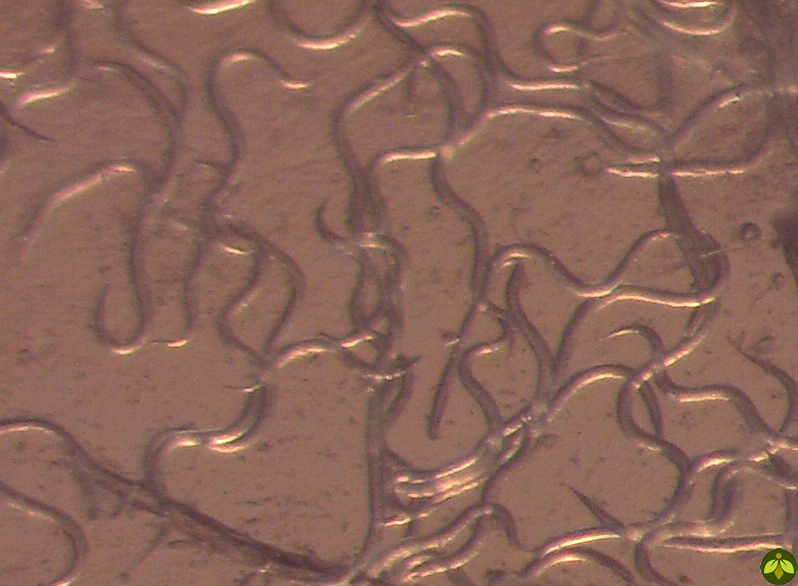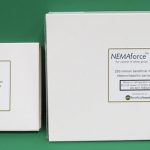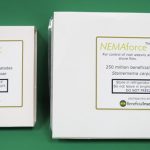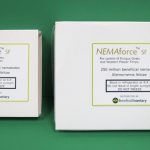Description
 Beneficial nematodes (Steinernema feltiae, Steinernema carpocapsae and Heterorhabditis bacteriophora) are used for the control and management of various soil pests. These nearly-microscopic non-segmented roundworms called entomogenous nematodes live in the soil and spend their lives exploiting the larvae and/or pupae of over 200 organisms for their own gain.
Beneficial nematodes (Steinernema feltiae, Steinernema carpocapsae and Heterorhabditis bacteriophora) are used for the control and management of various soil pests. These nearly-microscopic non-segmented roundworms called entomogenous nematodes live in the soil and spend their lives exploiting the larvae and/or pupae of over 200 organisms for their own gain.
Steinernema feltiae (Sf) is the largest of the beneficial nematodes mentioned and are the product of choice when your problems concern more active, shallowly occurring pests: fungus gnat or mushroom fly larvae, etc. These nematodes feature a shallowly-present habit (0–3″), like S. carpocapsae, but an intermediate active-hunting “cruising” characteristic, like H. bacteriophora, which may make them superior to many other species for the purposes specified. In fact, due to their shallow-cruising nature, S. feltiae are said to be the best nematodes for fungus gnat larvae. They tolerate cold better than the others as well.
Steinernema carpocapsae (Sc) are the beneficial nematode of choice when your problems concern shore flies (Scatella stagnalis), flea larvae & pupae, billbugs, cutworms, sod webworms, strawberry root weevil, black vine weevil and many others.
Heterorhabditis bacteriophora (Hb) are the beneficial nematode of choice when your problems concerns lethargic, deeply planted pests: Japanese beetle larvae or grubs (Popillia japonica), for example. These nematodes boast a deep-moving (1–7″), active-hunting, “cruising” characteristic which make them superior to many other species for the purpose of grub control.
Other pests which can be controlled, or at least impacted, with one or more of the species discussed include: apple maggot pupae (Rhagoletis pomonella); cabbage root maggots (Delia spp.); carrot rust flies (Psila rosae); carrot weevils (Listronotus oregonensis); spotted and striped cucumber beetles (Diabrotica undecimpuncata howardi and Acalymma vittatum, respectively); flea beetles (Podagrica uniforma); many fruit borer species (Synanthedon spp.); June/May beetles (Phyllophaga spp.); leafminer spp. pupae (i.e. Liriomyza.trifolii); northern corn root worms (Diabrotica longicornis); onion maggots (Delia antiqua); potato tuber worms (Phthorimaea operculella); squash vine borers (Melittia cucurbitae); wireworms (Limonius spp.); and many more economically important pests.
Lifestyle
The beneficial nematodes physically enter the host (grub, maggot, larva) and kill it from within (endoparasitism). Before they can enter the host, though, it must be found. Both nematode species accomplish this by “tasting” or “sampling” the air (soil air) for the “flavors” of carbon dioxide, methane gas residues, and warmth.
Once inside the host, the nematodes begin feeding and reproducing. A bacterium present in the nematodes actually causes the host to be killed. The lifespan of these nematodes is roughly 8 weeks for Hb, 15 for Sc, and slightly more, up to 20 for Sf. The majority of the population progress through 4 immature stages. For the first three they live in-vivo (inside their host), at the fourth stage they’re ready to hit the road, and adulthood is spent in-vivo in their new host. Their life-cycle cannot progress beyond the fourth immature stage until they find a new host.
The conditions for optimum performance will be soil temperatures between 79–83°F for Hb with a low end of 65°F, 70–83°F for Sc with a low end of 60°F, and 70–79°F for Sf (which can handle the most cold) with a low end of 59°F.
Benefits
Nematodes are very inexpensive to use and provide fairly fast results. The first host death will occur within 48–72 hours of host penetration for Hb nematodes, 16–24 hours for Sc and within 24–36 hours for Sf. Grub control results can usually be maintained for 6–15 weeks. Not all will work right away, though and most will scatter soon after being put out unless there is a lot of host larvae available. Using new planting medium will probably spark the need for additional applications though, especially if a sphagnum peat-based product is being used as this tends to be the international source of fungus gnats. Other causes of shorter performance periods can include: allowing containerized plants to dry completely; ultraviolet light (UV) exposure and the use of a nematicide. (Nematodes are compatible with most other substances.)
Beneficial nematodes are very versatile. They can be applied a number of different ways, through both automated equipment and manually. They can be put through just about any irrigation setup and they’ll withstand up to 300 p.s.i. We’ve heard of people using buckets, watering cans, hose-end sprayers, pump-up handheld sprayers, backpack sprayers, boom trucks and all sorts of application vehicles, so it’s basically up to the user to decide how the nematodes will be applied. Versatility extends beyond the flexibility of their application. Parasitic nematodes attack a huge segment of the pest species which bother growers and this feature allows them to often be used successfully in cases where everything else has failed.



